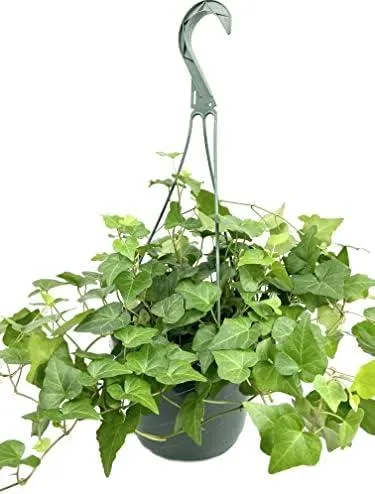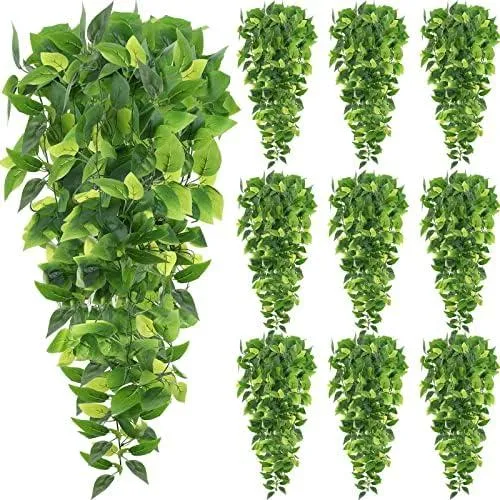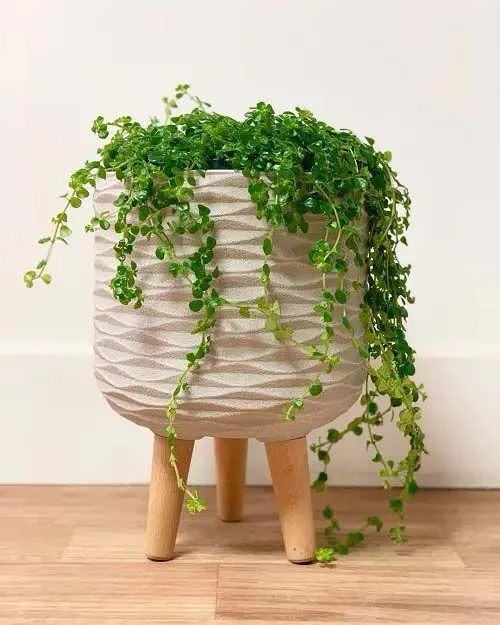A Comprehensive Guide to Growing Hanging Ivy Plants Indoors
Whether you’re looking to add some vibrant greenery to bare walls or seeking low-maintenance foliage for your home, hanging ivy plants make excellent indoor choices. With their trailing stems and dense foliage, ivies are versatile vines that thrive in hanging baskets, pots, or trained onto trellises. In this in-depth guide, I’ll cover everything you need to know to successfully grow ivy indoors, from choosing the right varieties to caring for your vines year-round.
Popular Indoor Ivy Plant Varieties
When selecting an ivy for indoor conditions, opt for varieties known to adapt well to lower light levels. Here are some top options:
- English ivy (Hedera helix): A vigorous classic with dark green leaves. Tolerates low light but grows fastest in bright spots.
- Swedish ivy (Plectranthus verticillaster): Colorful foliage in shades of green, purple, and white. Excellent for low-light rooms.
- Creeping fig (Ficus pumila): Forms a dense mat. Prefers partial shade. Avoid direct sun on leaves.
- Needlepoint ivy (Hedera helix ‘Needlepoint’): Decorative crinkled leaves. Thrives in low light but turn yellow without some sun.
Choosing a Pot or Hanging Basket
Ivies are ideal for hanging pots, macrame hangers, or shelves since their trailing stems spill over beautifully. Look for containers with drainage holes andchoose a size proportional to your vine’s mature size. For example, English ivy can outgrow a 6″ pot within a year. Fiberglass or plastic are lightweight options ideal for hanging.
Soil and Planting
Ivies thrive in well-draining soil mixes like potting soil amended with perlite or gravel for aeration. When planting, leave room for growth by not filling the container to the top. Water thoroughly until drained and hang in your desired spot. Some tips:

- Anchor with twist ties if using a hanging basket initially until roots take hold.
- Moss poles or trellises provide structure for vines to trail upon as they grow.
- Top-dress with moss or gravel for a finished look.
Light and Temperature Conditions
While ivies tolerate low light indoors, more sun equals better, bushier growth. East-, southwest-, or west-facing windows provide optimal indirect light. Avoid direct sun on foliage which can scorch leaves. Ivies do best at average room temperatures between 60-80°F. Too hot and leaves may Drop off.
Watering andHumidity
When the top 1-2 inches of soil dry out, water thoroughly until draining from the bottom. Some signs ivy needs water include drooping leaves and less sheen. Mist leaves occasionally to boost humidity, which ivies appreciate. Pebble trays or humidifiers also work, especially in winter heat.
Fertilizing
Feed ivies monthly in spring and summer with a dilute liquid houseplant food or all-purpose fertilizer according to label instructions. Too much nitrogen can cause leggy growth, so balance with phosphorus and potassium. Flush with plain water between feedings to prevent burns.
Pruning and Training
Ivies grow rampantly if unchecked. Prune off leggy stems or sections not growing where desired every few months. Cut just above a leaf node. Some vines like Swedish ivy can be trained and woven through structures for an attractive display. Use zip ties, string, or metal plant cages as needed.

Pests and Diseases
Scale, mealybugs, and spider mites occasionally bother ivies. Inspect regularly and wipe down leaves with soapy water if spotted. Cut off affected parts if infestations persist. Overwatering can lead to root rot, so allow soil to dry between waterings. Potential diseases include leaf spot which creates brown patches.
Propagation
Ivies are simple to propagate through stem or leaf cuttings. Snip 4-6 inch sections in late winter or early spring, remove lower leaves, and place stem ends in water. Change water weekly until roots form, usually 1-2 months. Pot up in soil and keep moist as new growth develops.
Tips for Successful Ivy Care
With some care and attention, ivies will reward you with lush growth for many years indoors. Here are some key best practices:
- Provide morning or indirect filtered light.
- Water only when soil surface dries out but keep slightly moist.
- Feed monthly spring to fall with balanced fertilizer.
- Prune to maintain shape and remove leggy growth.
- Boost humidity by misting or using pebble trays.
- Propagate through stem or leaf cuttings to expand your collection.
I hope this comprehensive guide has answered all your questions about growing hanging ivy plants indoors! Let me know if you need any clarification or have additional queries. With the right care, your ivies will add beautiful greenery and texture to any home for many seasons to come. Give these versatile vines a try – from my experience, you’ll be deeply satisfied with the results!

Important Details for Choosing and Caring for Hanging Ivy Plants Indoors
| Plant Type | Light Requirements | Watering Needs | Propagation Method |
|---|---|---|---|
| English Ivy | Partial to Full Shade | Allow Soil to Dry Out Between Waterings | Stem Cuttings |
| Heartleaf Philodendron | Low to Medium Light | Water When Top inch of Soil is Dry | Root Cuttings or Dividing Root Ball |
| Pothos | Low Light Conditions | Let Soil Dry Before Rewatering | Stem Cuttings |
| Spider Plant | Bright, Indirect Light | Water Thoroughly When Topsoil is Dry | Dividing Babies or Root Cuttings |
| Swedish Ivy | Low to Medium Light | Water When Top inch of Soil is Dry | Stem Cuttings |
FAQ
-
How do you plant a hanging ivy plant indoors?
Basically, you’ll need a pot with drainage holes, potting soil, and the ivy plant itself. Place drainage material like gravel or small stones in the bottom of the pot. Then add potting soil and push it firmly so it’s compact. Next, take the ivy plant out of its existing pot and untangle the roots if needed. Plant it in the center of the new pot and fill in around it with additional soil. Gently pat it down. Water thoroughly until it drains out the bottom. Place in a spot that gets partial or indirect sunlight. Maybe raise the pot if needed so the ivy can vine downwards.
-
What kind of light does indoor hanging ivy need?
Hanging ivy does well in medium to low light conditions. In other words, it can tolerate dim indoor lighting but thrives with some sunlight each day. Sort of like what you’d find near a sunny window. Direct sun may scorch the leaves, so indirect sunlight works best. The amazing thing about ivy is that it can even grow in very low light, like under bookshelves or cabinets. Seems this plant cares more about humidity than super bright conditions.
-
How often should you water a hanging ivy?
As a rule of thumb, water indoor hanging ivy when the top inch or two of soil becomes dry to the touch. Digress for a moment – does anyone else think “rule of thumb” is kind of an odd expression? Where did that come from anyway? Back to ivy care – in most homes, watering every 1-2 weeks should do the trick. Perhaps water a bit less often in winter when growth slows. Feel the pot weight before watering and only water if it feels light. Avoid soggy soil which can cause root rot.
-
Does hanging ivy need fertilizer?
You don’t absolutely need to fertilize a hanging ivy, but it won’t hurt to give it a little nutrient boost occasionally. Something like a diluted liquid houseplant fertilizer works well in the spring and summer when it’s actively growing. Just follow label instructions on how much to use. But is fertilizer really necessary? The plant seems pretty low maintenance. On the other hand, giving it a fertilizing may reward you with more lush growth. Up to you!

-
How do you prune or shape a hanging ivy?
Hanging ivy vines tend to grow long, so occasional pruning helps keep things under control indoors. You can snip stems back to encourage bushier growth. Cut vines above a set of leaves using clean Pruners or scissors. Keep plants looking full by removing any scraggly or dying sections. As an added bonus, fresh cuttings can be rooted in water or soil to start new plants. I did this once as a kids but am not sure if it actually worked, lol.
Is hanging ivy toxic to pets?
While hanging ivy may look beautiful cascading down from a pot, it can pose a risk if ingested by pets. Basically all parts of the plant contain calcium oxalate crystals which can cause mouth irritation and even kidney damage in cats and dogs. So keep hanging ivy high or out of reach if you have furry friends in the home. I know my cat gets into everything, so I’d feel awful if she took a nibble. Maybe ask your vet for plant safe options if decorating where pets can access.
Does hanging ivy need pruning in the winter?
For hanging ivy overwintering indoors, pruning isn’t really necessary during the colder months when the plant is dormant. I mean, you can trim off any totally dead or diseased parts. But otherwise, it’s best to leave ivy alone during its resting period. The plant puts its energy into root growth and establishing itself rather than tops. Come spring when new growth appears, that’s when light pruning can shape and inspire bushier regrowth. Hope this helps answer your question! Let me know if you need anything else.
